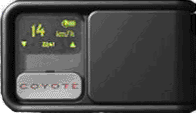Speeding drivers and social networking
By: Drivers.com staff
Date: 2008-12-01
Coyote Systems says its device is "based on the concept of the 21st century CB," and it's "the headlight flash of the 21st century."
The device they're talking about is the Mini-Coyote, a new GPS-based device that enables drivers to mark the positions of radar speed traps and speed cameras and pass the information on to their fellow drivers. It sells in the UK for about 200 pounds (about US$350).

When a driver who is a member of "the Coyote community" sees a speed trap they simply press a button on their device. This sends the location of the trap to a central processing center, which then sends the information out to all the other members.
By one account, the device can deliver the information in as little as 3 seconds - "which means that a car travelling 300 yards behind the driver who first spots the trap would receive the warning in time to slow down before the camera."
A partnership between Jasper Wireless, of Sunnivale, California, and the France-based Coyote Systems has produced the device. Locaton-Based Service (LBS) companies say it is "the first GPS-based alert system for Europe that informs drivers in real-time about the fixed and mobile speed cameras."
In effect, it's social networking for speeders!
Legal angles
Coyote Systems says it has sold about 70,000 of the Mini-Coyote devices in France since its launch about two years ago. It's also available in the Czech Republic and Slovakia, and will be launched in Benelux later in the year. It is already available in the UK and will be launched in Spain, Italy and Portugal in the first quarter of 2009.
Coyote reports that there are1,200 fixed cameras and 5,000 mobile radars on the road in France and that the Coyote community now comprises more than 40,000 users. The UK reportedly has about 6,000 road cameras and 20,000 mobile units.
Coyote also maintains there's an average of 5,000 vehicle locations per minute from users of the device in France and that the threshold for effectiveness has been reached.
The reactions of the safety and law enforcement communities seems to be mixed. Sometimes police accept the warnings as helping them lower traffic speeds. Then again, drivers who flash their headlights as a warning to oncoming motorists have, on occasion been charged with obstructing justice.
However, it's difficult to make such charges stick. As one UK blogger pointed out following the acquittal of a truck driver charged with flashing a headlight warning, how do you justify charging a driver when organizations such as the UK Automobile Association (in its road atlas) and the French Road Safety Administration actually publish the locations of speed cameras. Should the head of the AA then be charged with obstruction?
In France, and in the UK, speed trap radar detectors are illegal, whether in use of not. The Mini-Coyote, however, is not a radar detector but a GPS locator combined with a social networking service.
In March, 2006, UK minister of Transport Stephen Ladyman spoke out in their defense. The GPS devices "compliment the government's policy to ensure camera sites are visible and conspicuous to drivers, and so help deter excessive and inappropriate speeds on the roads," the Minister said.
Ladyman and Tory MP Owen Paterson admitted that they both used GPS speed camera warning systems in their cars.
Dr Ladyman said the devices "will continue to be perfectly legal. I have one myself." Mr Paterson reckoned the device "has made me drive better."
"If there was any doubt before, there isn't now," states CoyoteSystems' web site. "GPS speed camera warning systems are 100 per cent legal - and that's official!"
Comments to this article have been disabled.
